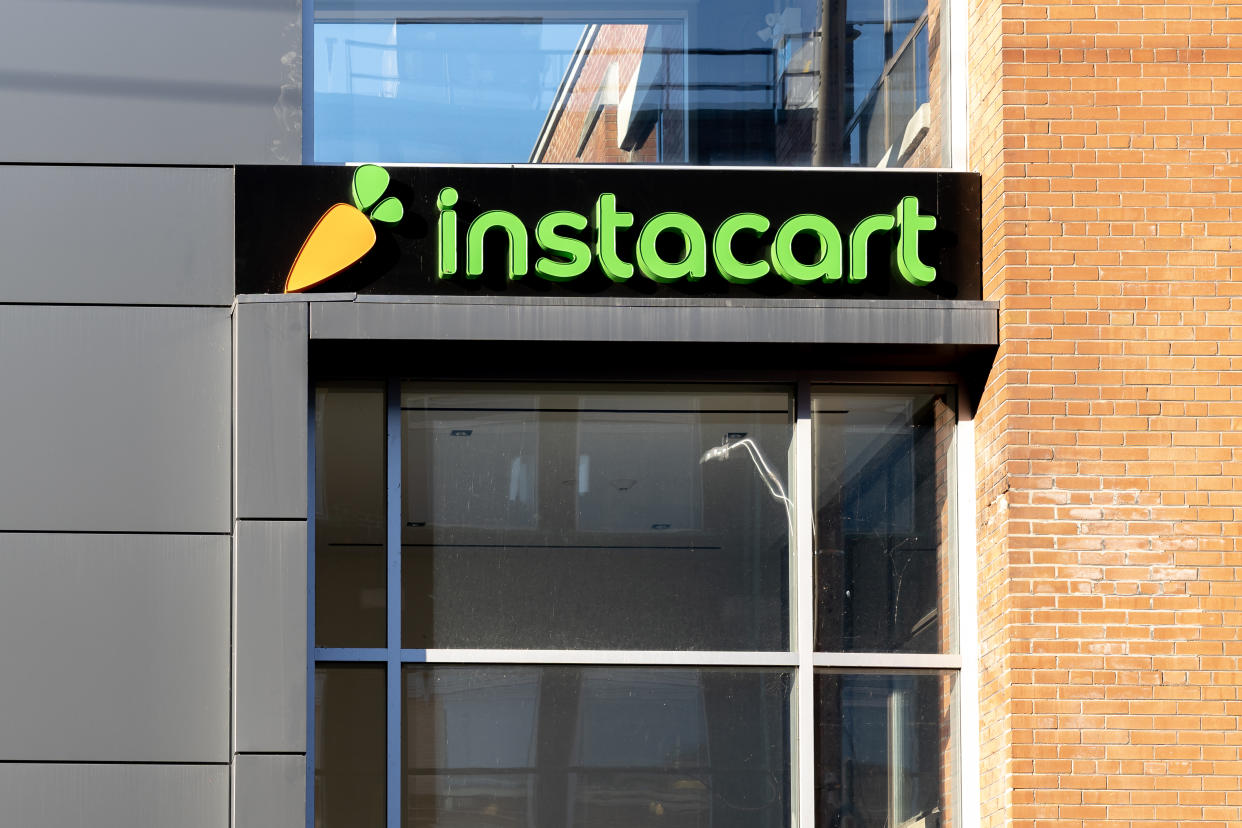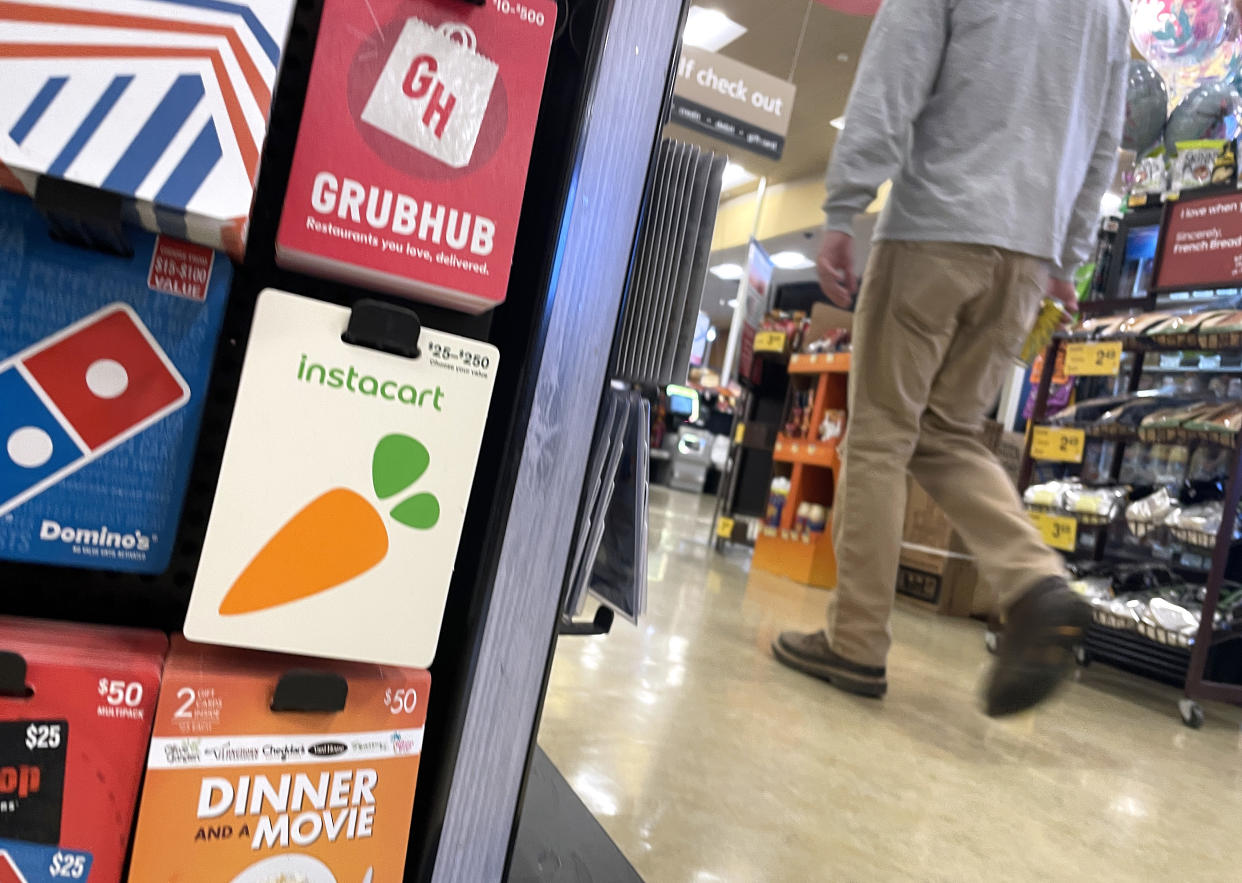Instacart IPO: Why the odds may be against the grocery delivery chain in its public debut
Instacart (CART) is officially on the public market.
On Tuesday, the grocery delivery company went public on the Nasdaq. Instacart stock opened at $42 a share, 40% higher than the anticipated $30 a share, which put the company's market valuation at roughly $13.9 billion.
As of the market close on Tuesday, shares of Instacart were up 12%, ending the trading session at $33.70.
Although the stock was expected to pop, it remains to be seen if it can hold on to that momentum. There are significant challenges up against Instacart this year.
"Instacart's strong market debut likely reflects the markets' willingness to pay for growth, especially for tech-enabled assets, as well as Instacart's position as a market leader in food delivery," PitchBook analyst Alex Frederick told Yahoo Finance. "Enthusiasm for the company will be challenged by its ability to sustain margin expansion and revenue growth while facing elevated food price inflation and increased competition from food delivery providers, Walmart, Amazon, and traditional grocers."

Initial pop may be above company's 'intrinsic valuation'
Instacart's public debut has been a long time coming. It's the first venture-backed tech IPO since 2021.
On a fully diluted basis, Instacart was priced for a market valuation of $10 billion, nearly 70% less than its private valuation of $39 billion in 2021 at the height of the pandemic, per Pitchbook data.
"This is still a big haircut from that peak valuation that they got privately of some $39 billion," Renaissance Capital's Matt Kennedy told Yahoo Finance. "I think it makes sense. ... The company is getting valued not in a 2021 environment but a 2023 environment."
Instacart is making its debut in an IPO market that is gradually regaining momentum after a long dry spell, and that can mean more price volatility for names gaining a lot of attention.
Last week, British chipmaker Arm (ARM) went public, receiving a favorable reception from investors. Meanwhile, enterprise software company Klaviyo (KYVO) is expected to make its public debut on Wednesday, and shoemaker Birkenstock is expected to go public in mid-October.
"I think that with some of the recent IPOs, you've seen a lot of excitement and a lot of pent-up demand for quality tech IPOs," Kennedy told Yahoo Finance. "And sometimes that can mean an initial pop that is maybe well above what the intrinsic valuation should be."

Consumers' willingness to pay up for grocery delivery
In August, grocery prices were up yet again, hitting Instacart's partners like Kroger (KR) and Costco (COST).
Compared to last year, the cost of food at home rose 3% in August, according to the Bureau of Labor Statistics' (BLS) August Consumer Price Index (CPI), versus a 3.6% increase in July.
"From [an] overall and food inflation standpoint, ... I feel the first half of this year was a lot tougher for a company like Instacart as compared to the next six to nine months, given where we are as far as the trade line and inflation is concerned and the likelihood of interest rates not rising any further again," Roth MKM managing director Rohit Kulkarni told Yahoo Finance.
According to a regulatory filing, Instacart's orders were flat in the first half of 2023 compared to a year ago at $132.9 million while the average order value rose 4% to $112. Instacart expects higher order levels in the back half of the year in part due to the back-to-school period and holiday season.
However, the company could run into challenges there too if more consumers leave the platform.
"Recently, Instacart boosted profits by raising fees, at the expense of reducing growth in the number of users," University of Florida professor and IPO expert Jay Ritter told Yahoo Finance. "Most consumers are only willing to pay a limited amount to have groceries delivered, and many consumers want to do a lot of grocery shopping themselves. So one issue is trying to find the sweet spot that balances fewer users versus higher profits per user."
Growing competitive threats
Morningstar analyst Ali Mogharabi highlighted the risk from big grocery players like Kroger creating their own services and taking share from Instacart.
For instance, Walmart+ now offers free grocery delivery and recently announced a half-price membership for US consumers on government assistance.
"Even though some of the big groceries ... do have a stake in the company, they also do have more than enough capital at hand to create similar services for themselves to basically do what Instacart has been doing for them and create it in-house," Mogharabi said.
Instacart also faces comparisons with competitors DoorDash (DASH) and Uber's (UBER) UberEats business. Since its IPO in 2020, DoorDash stock is down nearly 60%.
"The most surprising aspect [of Instacart's regulatory filing] was that Instacart is not only significantly smaller but also growing much slower than its peers," Kulkarni said. "One would expect a smaller company might grow faster."
In comparison to Instacart's $10 billion market value, DoorDash's current market cap is more than $30 billion, whereas Uber's business is valued at more than $95 billion.
And Instacart's gross transaction value has been on the decline recently, skyrocketing 303% from 2019 to 2020 before fading to 20% from 2020 to 2021 and 16% from 2021 to 2022. In the first quarter of this year, gross transaction value was up just 3% year over year.
Margins are also better for DoorDash and Uber, as they tend to be higher for restaurants than for groceries.
"If you ordered $100 worth [of] bacon [and] eggs from your local grocery store, Instacart would keep anywhere between $8 and $9 as their own revenues and give back $92 to your local grocery store," Kulkarni said. "On a comparable basis, DoorDash would keep something like $12 or $13 from the restaurant and Uber would keep something in the range of $20."
"We do see a path to higher margins," Kulkarni added, but "not at the DoorDash levels or some of their competitors, [like] UberEats."
Still, despite the challenges, Kulkarni noted that in going public, Instacart already cleared a fairly high bar.
"[The] new wave of IPOs are probably going to be more name brand, battle-tested companies," Kulkarni said. "So the quality of preparedness is going to be much higher."
—
Brooke DiPalma is a reporter for Yahoo Finance. Follow her on Twitter at @BrookeDiPalma or email her at bdipalma@yahoofinance.com.
Click here for the latest stock market news and in-depth analysis, including events that move stocks
Read the latest financial and business news from Yahoo Finance
